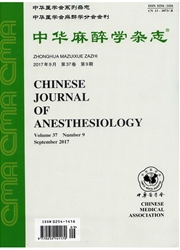

 中文摘要:
中文摘要:
目的评价鞘内注射驱动蛋白17竞争性小肽抑制剂RC-13对骨癌痛小鼠的镇痛效果。方法雄性C3H/HeJ小鼠40只,6~8周龄,体重20。25g,采用随机数字表法,将其随机分为5组(n=8):假手术组(S组)、骨癌痛+5μlDMSO组(Ro组)、骨癌痛+2.5μgRC-13组(R.组)、骨癌痛+5μg RC—13组(R组)和骨癌痛+10愕RC-13组(R3组)。‰组、R1组、R2组和R3组小鼠右侧股骨骨髓腔内注射含约2×105个纤维肉瘤细胞的20μla.MEM以制备骨癌痛模型。骨癌痛各组于接种肿瘤细胞后第14天开始,每天定时分别鞘内注射10%DMSO5μl和溶于10%DMSO的RC-132.5μg/5μ1、5μg,5μg、10μg,5μl,连续3d,每天1次。各组于接种前1d、接种后3、5、7、10、14d时测定小鼠机械缩足阈值和自发抬足次数,R0~3组在给药结束后1、3、5和7d时行相同行为学测定。结果与S组比较,其余组接种后7~14d时小鼠机械缩足阈值降低,自发抬足次数增加(P〈0.05);与R11组比较,R2组给药结束后1d、R2组1和3d、R3组1、3、5d时机械缩足阈值升高,自发抬足次数减少(P〈O.05);与R1组比较,R2组给药结束后3d、R1组1、3、5d时机械缩足阈值升高,自发抬足次数减少(P〈0.05);与R组比较,R2组给药结束后1和3d时机械缩足阈值升高,自发抬足次数减少(P〈O.05)。结论鞘内注射驱动蛋白17竞争性小肽抑制剂RC-13对骨癌痛小鼠具有良好的镇痛效果,其效应呈剂量依赖性。
 英文摘要:
英文摘要:
Objective To investigate the analgesic efficacy of intrathecal injection of RC-13, a competi- tive kinesin superfamily protein 17 antagonist, in a mouse model of bone cancer pain. Methods Forty male C3H/HeJ mice, aged 6-8 weeks, weighing 20-25 g, were randomly divided into 5 groups ( n = 8 each) : sham op- eration group (group S); bone cancer pain + '5 kd dimethyl sulfoxide (DMSO) group (group Ro ); bone cancer pain + 2.5 /~g RC-13 group (group Ri ); bone cancer pain + 5 ttg RC-13 group (group R2 ) and bone cancer pain + 10 /~g RC-13 group (group R3 ) . In groups Ro.3 , bone cancer pain was induced by implantation of ct-min- imal essence medium (a-MEM) containing osteosarooma NCTC 2472 cells into the intramedullary space of right fe- mur. In group S, culture medium ct-MEM containing no cancer cell was injected instead. 10% DMSO 5 $1 and RC-13 2.5 ~g/5 /~1, 5 ttg/5 /11 and 10 ttg/5 ttl dissolved in 10% DMSO were injected intrathecally in groups Ro_s , respectively, once a day for 3 consecutive days starting from 14th day after inoculation of the tumor ceils. Pain be- havior was assessed by the paw withdrawal mechanical threshold (PWMT) and spontaneous lifting times (SLTs) measured at 1 day before inoculation and at 3, 5, 7, 10, 14 days after inoculation. The same tests were also performed at 1, 3, 5 and 7 days after administration in groups R0.3 . Results Compared with group S, PWMT was significantly decreased and SLTs were increased at 7-14 days after inoculation in the other groups ( P 〈 0.05 ). Compared with group Ro , PWMT was significantly increased and SLTs were reduced at 1 day after administration in group Ri , at 1 and 3 days after administration in group R2, and at 1, 3 and 5 days after administration in group R3 ( P 〈 0.05 ) . Compared with group Ri , PWMT was significantly increased and SLTs were reduced at 3 days after administration in group R2 , and at 1, 3 and 5 days after administration in group R3 ( P 〈 0.05). Compared with gro
 同期刊论文项目
同期刊论文项目
 同项目期刊论文
同项目期刊论文
 Intraperitoneal injection of thalidomide attenuates bone cancer pain and decreases spinal tumor necr
Intraperitoneal injection of thalidomide attenuates bone cancer pain and decreases spinal tumor necr Intrathecal administration of roscovitine attenuates cancer pain and inhibits the expression of NMDA
Intrathecal administration of roscovitine attenuates cancer pain and inhibits the expression of NMDA Antinociception and prevention of hyperalgesia by intrathecal administration of Ro 25-6981, a highly
Antinociception and prevention of hyperalgesia by intrathecal administration of Ro 25-6981, a highly Senegenin Attenuates Hepatic Ischemia-Reperfusion Induced Cognitive Dysfunction by Increasing Hippoc
Senegenin Attenuates Hepatic Ischemia-Reperfusion Induced Cognitive Dysfunction by Increasing Hippoc The activation of spinal astrocytes contributes to preoperative anxiety-induced persistent post-oper
The activation of spinal astrocytes contributes to preoperative anxiety-induced persistent post-oper The Efficacy of NMDA receptor antagonists for preventing remifentanil-induced increase in postoperat
The Efficacy of NMDA receptor antagonists for preventing remifentanil-induced increase in postoperat Intrathecal injection of KN93 attenuates paradoxical remifentanil-induced postoperative hyperalgesia
Intrathecal injection of KN93 attenuates paradoxical remifentanil-induced postoperative hyperalgesia The Effect of NR2B Subunit Palmitoylation at the Spinal Level After Chronic Dorsal Root Ganglia Comp
The Effect of NR2B Subunit Palmitoylation at the Spinal Level After Chronic Dorsal Root Ganglia Comp Regulation of the NR2B-CREB-CRTC1 Signaling Pathway Contributes to Circadian Pain in Murine Model of
Regulation of the NR2B-CREB-CRTC1 Signaling Pathway Contributes to Circadian Pain in Murine Model of Intrathecal administration of roscovitine prevents remifentanil-induced postoperative hyperalgesia a
Intrathecal administration of roscovitine prevents remifentanil-induced postoperative hyperalgesia a Intrathecal Injection of JWH015 Attenuates Remifentanil-Induced Postoperative Hyperalgesia by Inhibi
Intrathecal Injection of JWH015 Attenuates Remifentanil-Induced Postoperative Hyperalgesia by Inhibi The inhibitor of calcium/calmodulin-dependent protein kinase II KN93 attenuates bone cancer pain via
The inhibitor of calcium/calmodulin-dependent protein kinase II KN93 attenuates bone cancer pain via Neuron-restrictive silencer factor in periaqueductal gray contributes to remifentanil-induced postop
Neuron-restrictive silencer factor in periaqueductal gray contributes to remifentanil-induced postop The cyclic AMP response element-binding protein antisense oligonucleotide induced anti-nociception a
The cyclic AMP response element-binding protein antisense oligonucleotide induced anti-nociception a 期刊信息
期刊信息
